Progress report for LNE22-453R
Project Information
This research will investigate opportunities to meet identified farmer needs to reduce energy-intensive agricultural inputs, participate in sustainable nutrient cycling, and promote soil health, through the reclamation of human waste as fertilizer in the form of biosolids-based biochar and source separated human urine. We will investigate their soil health effects in comparison to conventional and organic amendments, including wood-derived biochar. We will conduct social research with farmers to understand their perceptions of biosolids biochar, a novel amendment, and determine what further research or best practices may be required for this product to be adopted by farmers in the Northeast.
This research investigates a novel approach to meeting the identified farmer needs of reducing energy-intensive agricultural inputs, participating in sustainable nutrient cycling, and promoting soil health. Our approach is to accomplish these goals through the reclamation of human waste as fertilizer, in the form of biosolids-derived biochar and source separated human urine. Producing biochar from biosolids offers an opportunity to convert a waste into a value-added product that can increase soil organic matter in soils, help mitigate climate change, and improve crop production, while reducing the need for additional external inputs. The benefits of biochar are known to be enhanced further when biochar has been charged/inoculated/blended with nutrient rich materials before use, such as urine-derived fertilizer. Thus, using both the solid and liquid human waste products could be a way to reduce the need for external synthetic fertilizers and use both forms of waste simultaneously.
Our project evaluates the potential for adoption of these novel human waste-derived soil amendments through a 3-year field experiment measuring the effect of these amendments on soil health, and through social research on farmer attitudes and perceptions.
The field experiment, using corn, examines how combinations of source-separated human urine, biomass biochar, and biosolids biochar affect soil health, crop yield, and nutrient leaching, compared to currently-used conventional and organic amendments. We are using the following nine treatments: Control (no amendments); Urea; Urine; Compost; Compost + urine; Biomass biochar + urine; Biosolids biochar + urine; Biosolids biochar + urine (with annual reduced-rate biochar application); and Compost + biosolids biochar + urine.
The social research component builds on our previous SARE projects, which documented strong farmer interest in and adoption of source-separated human urine as fertilizer. However, we also identified concerns about urine related to potential soil health effects from residual pharmaceuticals, and concerns about biosolids related to microcontaminants, organic pollutants, and heavy metals. The use of biosolids biochar combined with urine may allay these farmer concerns, because the high-temperature conversion of biosolids to biochar eliminates many organic contaminants and immobilizes heavy metals. Furthermore biochar has been shown to immobilize organic contaminants, such as the residual pharmaceuticals in urine. Our goal will be to understand farmer perceptions of biosolids biochar, a novel amendment, and determine what further research or best practices may be required for this product to be adopted by farmers in the Northeast. Social research will include 20 farmer interviews, a regional survey, and farm field days.
Cooperators
- (Educator and Researcher)
- (Researcher)
- (Researcher)
- (Educator and Researcher)
- (Researcher)
- (Researcher)
- (Researcher)
Research
Hypothesis
We hypothesize that there are positive effects on soil health and crop yield through using biochar and soluble fertilizer combinations in comparison to their use alone. We anticipate that these benefits can be achieved using two recycled amendments: source-separated urine and biosolids biochar. Our project will evaluate the potential for adoption of these novel human waste-derived soil amendments through investigating:
- How urine, biomass biochar, and biosolids biochar affect soil health, compared to currently-used conventional and organic amendments.
- The questions, concerns, and recommendations of farmers, including specific indicators of soil health they consider important with respect to the tested amendments.
Materials & Methods
SOIL HEALTH
Field trials are being conducted: 1) on a commercial farm, in Brattleboro, VT, and 2) at the Cornell University Long Island Horticultural Research and Extension Center in Riverhead, NY. Urine used in the study is pasteurized to meet Class A biosolid standards and sourced from near Brattleboro, VT. The urine used for the NY trials was shipped from Vermont.
We originally intended to begin the field trials in 2022, but due to the short period of time between funding of the grant and the beginning of the field season, we determined that was not feasible. We therefore focused on planning and procurement of materials in 2022, and began the field trials in 2023. Baseline soil health samples were collected in late winter/early spring 2022.
Treatments
Nine treatments were selected to include a range of soluble and organic forms of nitrogen, along with labile (quick-to-decompose) organic carbon, recalcitrant (slow-to-decompose) organic carbon, or negligible levels of organic carbon. The treatments are listed below, and then in a table to show their distribution along two axes representing different forms of carbon and nitrogen:
Treatment
- Control (no amendments)
- Urea
- Urine
- Compost
- Compost + urine
- Biomass biochar + urine
- Biosolids biochar + biomass biochar + urine
- Biomass biochar + compost + urine
- Biosolids biochar + biomass biochar + compost + urine
|
Organic carbon characteristics |
|||||
|
Labile |
Labile and recalcitrant |
Mostly recalcitrant |
None/ negligible |
||
|
Nitrogen characteristics |
Soluble |
Biochar + urine (#6,7,8) |
Urea (#2) Urine (#3) |
||
|
Soluble and organic |
Compost + urine (#5) |
Compost + biochar + urine (#9) |
|||
|
Mostly organic |
Compost (#4) |
||||
This design allows evaluation of the multi-year effect of applying labile carbon paired with organic nitrogen (N), compared to primarily recalcitrant carbon paired with soluble N. Intermediate treatments contain a combination of both types of N and carbon, to examine synergistic effects. The two low-to-no-carbon fertilizers and the control offer fertilized and unfertilized comparisons to the high-carbon treatments. The experiment also directly compares biomass biochar and biosolids biochar.
Amendment application rates for all treatments (except the control) are calculated to meet the agronomic N needs of silage corn. Supplemental phosphorus (P) and potassium (K) will be added if needed as indicated by soil tests. The treatments where both urine and compost are applied receive compost to meet all carbon requirements and urine to meet remaining N requirements. Compost (sourced from Vermont Compost Co.) was broadcast applied before tilling. Urine and urea were split between a planting application and mid-season sidedress, and applied in a band 2-3” below the soil surface and 4-6” away from the corn row.
Biomass biochar was produced from Southern Yellow Pine pyrolyzed at 800°C, and biosolids biochar was pyrolyzed at 600°C. Biochar was charged by mixing with compost or urine 1-2 weeks before surface application in Year 1. For the biochar treatments, biochar was mixed with urine and broadcast applied before tilling. Biochar application rates were chosen in consultation with project Advisory Committee members.
Methods
Two field experiments were established, one on Long Island and one in Vermont, both using a randomized complete block design. Each field location contains 45 subplots, to accommodate five replicates of nine treatments. Subplots measure 20’ long and contain four rows of silage corn. Subplot width is 12’ in VT and 11.3’ in LI due to the different spacing of the corn planting machines at the two locations. Harvest sampling occurred within the center 16’ of the middle two rows.
At both field trial locations:
Before season 1:
Baseline soil health and nutrient samples were collected and sent to the Cornell Soil Health Lab for the Comprehensive Assessment of Soil Health (CASH) standard analysis.
During each of the three growing seasons:
- Terminate winter rye cover crop using herbicide. On April 8, 2023 herbicide (glyphosate) was applied to terminate the winter rye cover crop prior to trial establishment at the Long Island site. No herbicide was applied in 2024 to terminate the cover crop at the LI trial location and instead a lite disking was to terminate the cover crop. No herbicide was applied at the VT trial location prior to planting.
- Surface-apply compost and charge biochar to appropriate treatments. Surface-apply supplemental phosphorus and potassium to appropriate treatments.
- Till the entire field.
- Plant silage corn.
- Apply synthetic fertilizer and urine treatments using standard practices: band applied 2-3” below the soil and 4-6” away from each row.
- Apply herbicide (VT). At the Long Island trial location, herbicide (glyphosate) was applied on June 9 and 26, 2023, to manage weeds and on June 12, in 2024. At the VT location, herbicide (glyphosate) was applied to terminate weeds post-planting.
- At mid-season, test leaf chlorophyll levels using a SPAD meter, and sample soil for pre-sidedress nitrogen testing (PSNT) on all subplots
- Side-dress corn with the remaining N using appropriate fertilizer sources for that treatment. (We did not use the PSNT or SPAD results to determine sidedress N rates but instead just applied the remaining N as determined by the treatment.)
- Collect yield data: biomass and forage analysis.
- Collect soil nutrient samples (years 1 & 3 only) (A composite field sample was taken in year 1, subplot samples will be taken in year 3.)
After season 3:
Collect soil health samples from each subplot in Fall 2025.
Soil health testing will be done again using the CASH test. Soil health samples provide information on a soil’s physical, chemical, and biological properties, allowing for more holistic or systems thinking approaches to management. Through separate funding, longer-term microbial analyses will be conducted concurrently from samples collected in spring 2023 and 2027.
Lysimeters were installed in year 1 at the Long Island Trial site to collect data on nitrogen leaching from the different treatments. Leachate was collected at various times throughout the study from the lysimeters but unfortunately, we were unable to collect samples from several of the lysimeters in the trial despite multiple attempts. Due to variability in performance of the lysimeters over the course of the season and the lack of samples to perform statistical analysis of the data, it was decided to forgo the lysimeter component of the project moving forward.
For years 1 and 2 data, an analysis of variance (ANOVA) was used to determine significant differences between treatments at each location (p < .05). The analysis included the main effects of treatment, location, and year. A Tukey HSD test (p < .05) was performed to determine pairwise significance between treatments at each location and year. All data analyses were performed in R Version 4.2.1 (R Core Team, 2022). Results will be disseminated through the final report, farmer field days, conferences, and at least one article for the peer reviewed literature and one for trade literature. (See "Farmer Outreach" section for specific journals to be targeted.)
Seasons 1&2 Update:
In mid-April, 2023, baseline soil samples were collected from each of 45 subplots in both VT and LI plots and submitted for amplicon sequencing (Cornell University, NY) and phospholipid fatty acid (PLFA) analysis (Soil Health Assessment Center, Columbia, MO). This was done using funding from the Foundation for Food & Agriculture Research for conducting an add-on component to this study examining impacts of the treatments on soil microbiology.
In the spring of both 2023 and 2024 seasons, compost, biochar amendments, and triple superphosphate (TSP) and potassium chloride (KCl) fertilizer supplements were applied to subplots according to the treatments detailed above. Compost was distributed evenly from a 5-gallon bucket to each plot, the boundaries of which were marked with a 20’ x 12’ subplot grid (Figure 1). Biochar amendments were weighed into 5-gallon buckets and mixed with urine in a 1:1 ratio to “charge” the biochar one week prior to application. Charged biochar was applied to field plots by evenly dispersing it from the 5-gallon buckets over the subplot grid. TSP and KCl amendments were applied to subplots using a hand-pushed fertilizer cart (VT site) and by hand (LI site).
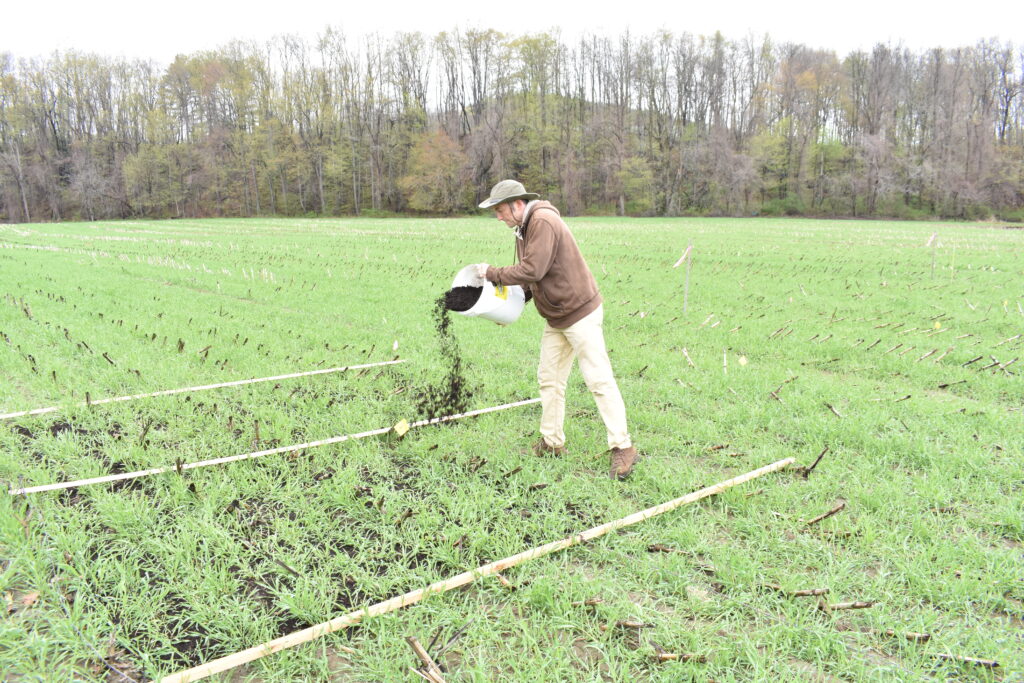
The field was tilled and planted with corn in May. When seedlings emerged in late May, the first of two applications of urine and synthetic urea amendments were applied to their respective treatments. Both urine and urea were applied to furrows (2” deep and 2” from seedlings) and covered with a rake following application. Urine was applied evenly to each furrow using a hand-held applicator which was similar to a watering can. Urea was applied by shaking pellets evenly into furrows from a hand-held container (Figure 2).
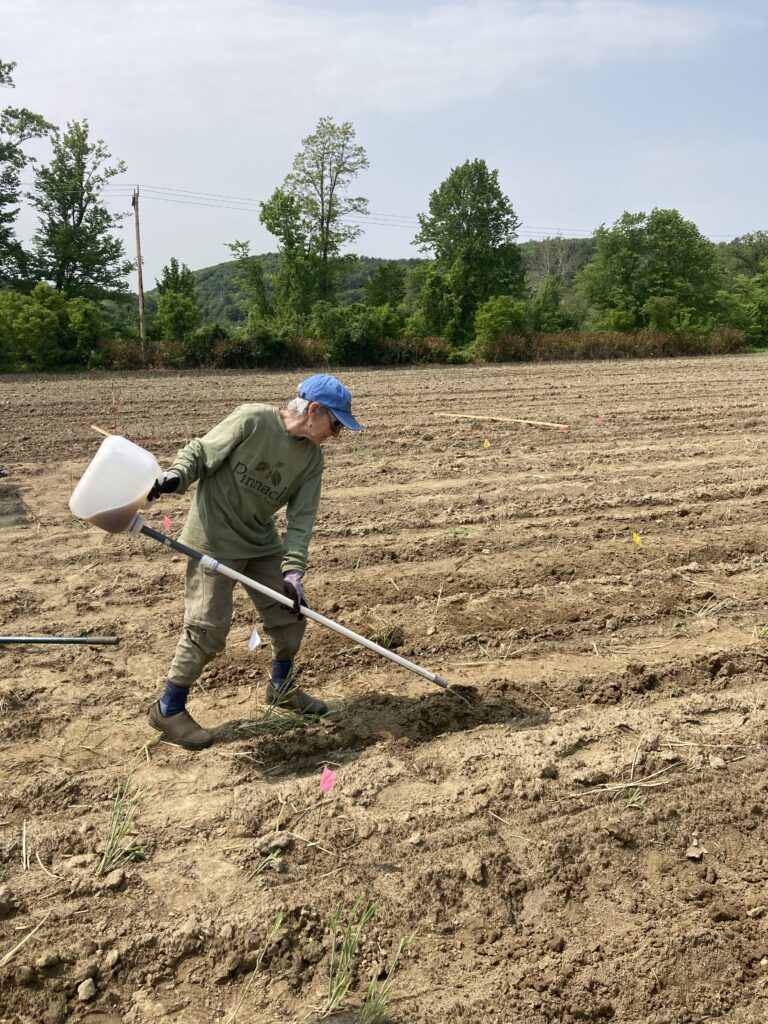
In late June, PSNT and SPAD testing was performed in each subplot. PSNT soil samples were sent to DairyOne Labs for analysis, and results from both PSNT and SPAD analysis indicated low nitrate availability. Sidedress urine and urea applications were applied to respective treatments using the methods from the prior application, with furrows (2” deep and 6” from plants) on both sides of a corn row to account for the greater volume of urine applied at this time (Figure 3).
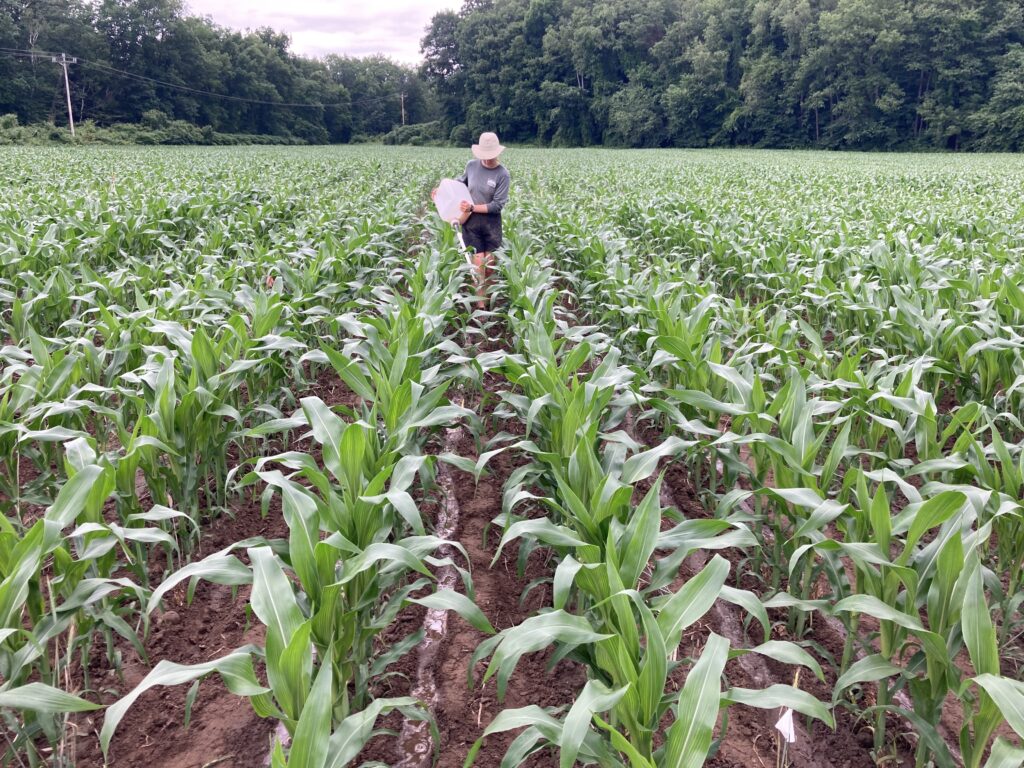
In mid-September, the corn of each subplot was harvested and the wet weight recorded. A subsample of shredded stalk and leaf material was sent to DairyOne Labs for forage analysis (Figure 4). For eight ears in each subplot, variables of 1) ear length, 2) length of ear with developed kernels, and 3) the number of kernel rows were measured and recorded. Corn kernel measurements were not taken at the LI field location in 2024 due to heavy bird damage of corn ears.
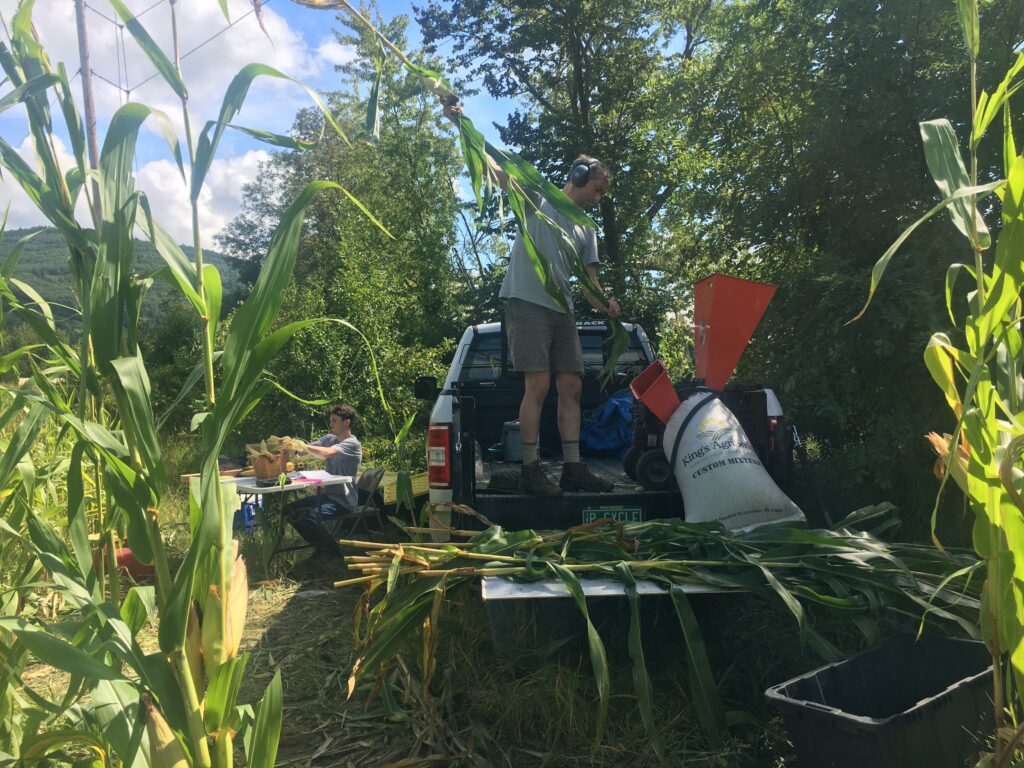

SOCIAL RESEARCH
Our social research aims to understand farmer perspectives on the novel amendments studied in this project. We are analyzing farmers' questions and concerns, and identifying opportunities for and barriers to adoption (including economic factors) to inform our research and education strategies. We are also identifying specific indicators of soil health that are most important to farmers. To accomplish this, we are utilizing an iterative farmer engagement process, creating opportunities for participation through interviews, small dialogue groups at field days, and a regional survey.
Years 1 & 2
Interviews are being conducted with 20 farmers in New England and on Long Island in NY, to identify opportunities for implementation and future research needs. With Advisory Committee help, we are selecting farmers representing a diversity of operations, with specific effort to include farmers who currently use biochar or biosolids (or have demonstrated interest in such use), as well as BIPOC and women-owned enterprises. Interviews include current nutrient management practices; decision making about farm/soil management; ideas/concerns about the novel amendments of this study; suggestions for both consumer oriented and farmer-to-farmer educational materials; and soil health information needs. Interviews are being recorded, transcribed and coded for analysis, using standard triangulation protocols for qualitative research (Saldana, 2016). Results from our interview analysis will be used to inform the ongoing research plan.
Year 3
A farmer survey will be disseminated to farmers across the Northeast region through networks identified in the Farmer Engagement section above. The survey will be used to gather perspectives on the potential adoption of the tested amendments, including barriers, opportunities, and outstanding questions. The survey will introduce preliminary results compiled from field trials and interviews, and solicit additional recommendations for educational materials.
We will also host a field day at each test site (one in NY and one in VT) to share study results with farmers, agricultural educators, and others and gather participants' feedback, questions and concerns. We will provide educational materials to share with farmers, informed by prior social and technical results, and facilitate break-out groups to discuss and evaluate the educational materials and their potential adaptation for different purposes. (See Steps to Adoption section above).
Data from the interviews, survey, and the small group conversations will be analyzed for dissemination via conferences, the final report, and articles for both trade literature and peer-reviewed journals. (See "Farmer Outreach" section above for specific journals.)
Year 1 & 2 Social Research Update:
We have identified a range of potential interviewees in Vermont and on Cape Cod and Nantucket in Massachusetts and Long Island in NY and continue to seek additional interviewees to ensure a diverse sample. We are behind in our goal of completing 20 interviews in Years 1 and 2, but the initial interviews represent diverse crops (e.g. ornamental shrubs, hemp, tomatoes, flowers) management history, scale of operation and farm types. We have expanded our thinking about the type of land managers to engage to include not only farms per se, but greenhouse operators and community gardeners, and some individuals involved with technical support for farmers. We anticipate completing the 20 planned interviews by March, 2025. We have developed analysis protocols, and are currently engaged in coding and analysis of the first group of interviews, which will inform our upcoming interviews as well as our Year 3 survey and field day dialogue.
Farmer Engagement
We received IRB approval through Cornell University for the social research component of the project. During Years 1 and 2 of the project, we identified a range of farmers to interview and with whom to conduct site visits in New England and New York. We decided to expand the range of potential interviewees to include farmers on Cape Cod, given Rich Earth's complimentary work with a range of actors in that region interested in reducing nitrogen effluent into waterways. We developed interview protocols (and revised these based on initial interview responses) and have been conducting interviews, but are currently behind in our goal of 20 interviews in Years 1 and 2. We intend to complete the remaining interviews in Jan - March of 2025.
SOIL HEALTH
All fertilized treatments had significantly higher yields (dry tons/acre) compared to the unfertilized control treatments in 2023 and 2024 trials at both trial locations (p < .05 ) (Figure 6). Location and year effects were not significant, and yield did not vary between fertilized treatments.
Average ear fill varied significantly by treatment for all years and locations (p < .05), except on LI in 2024, which had no data due to bird damaged ears (Figure 7). Unfertilized controls had significantly lower ear fills than all other treatments for each location and year. On LI, C and C + Urine treatments had significantly lower ear fills than the treatment receiving only urine (2023). In Vermont, the BBC + WBC + C + Urine treatment had significantly lower ear fills than Urea (2023), C (2023), and BBC + BWC + Urine treatments (2024).
Average ear length varied significantly by treatment for all years and locations (p < .05) (Figure 8). Unfertilized controls had significantly shorter ears than all other treatments in each location and year. On LI, the C + Urine treatment had significantly shorter ears than the Urine treatment (2023). In Vermont, the BBC + WBC + C + Urine treatment had shorter ears than WBC + Urine (2023 and 2024), Urea (2023), and Urine treatments (2024). Additionally in Vermont, the C + Urine treatment had shorter ears than the WBC + Urine treatment (2024).
Data analysis of silage and soil samples is not yet complete and will be included in the final report.
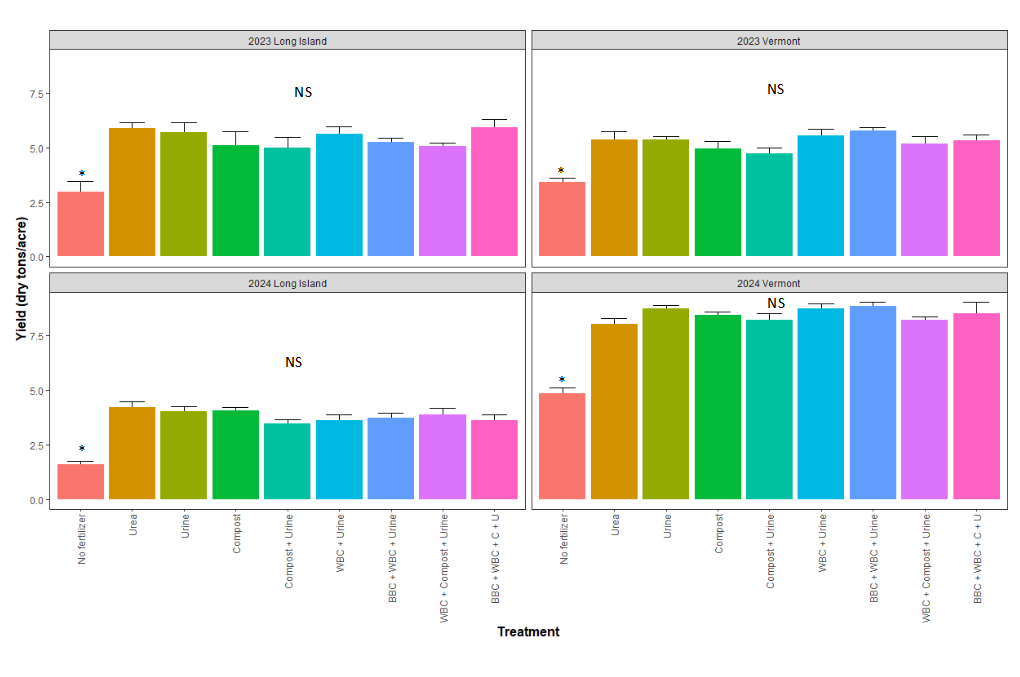
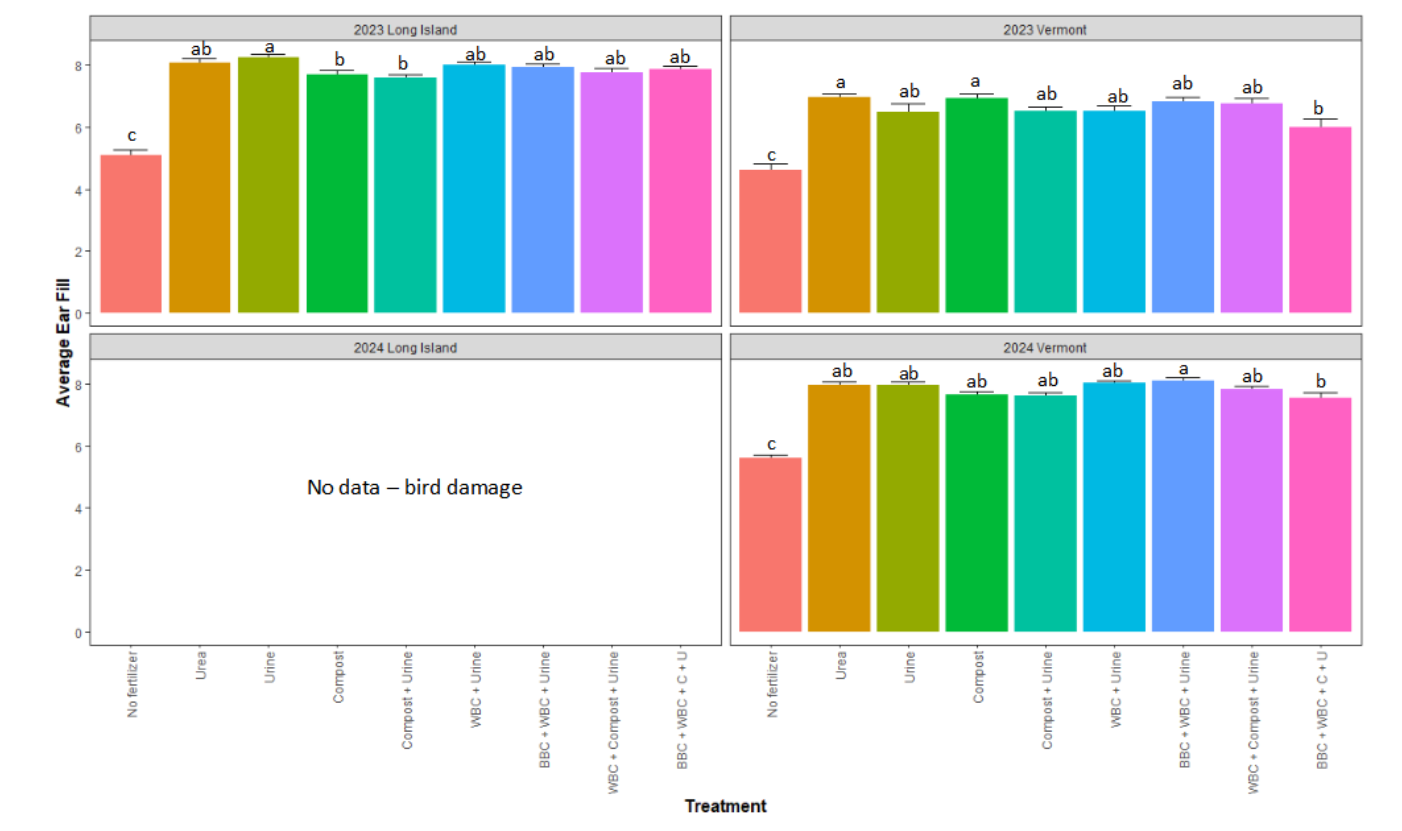
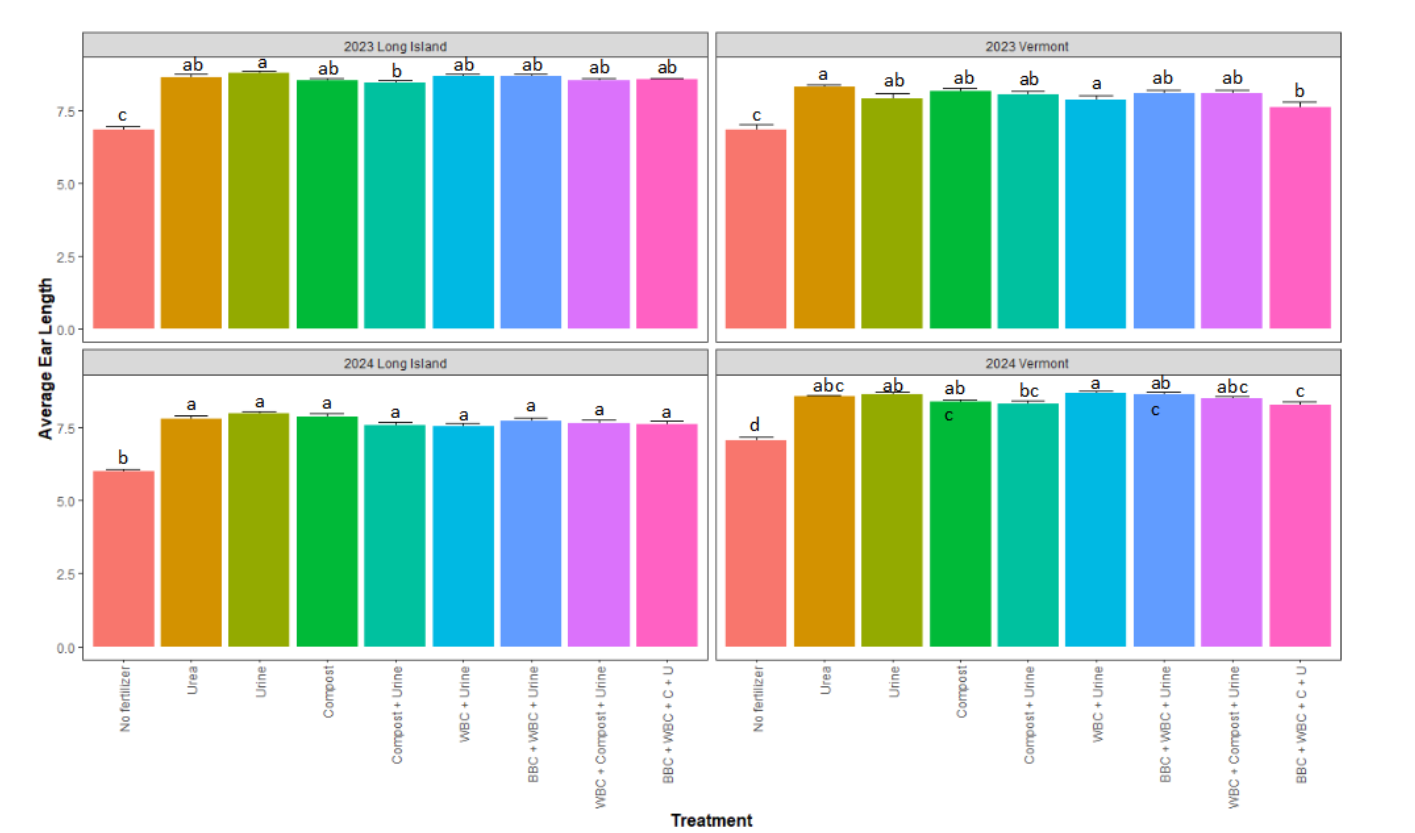
SOCIAL RESEARCH
With regard to recruitment of interviewees, we are aware of some selection bias in that those who have responded to our recruitment efforts so far may be those with most interest in this topic. With support of our Advisory Committee, we will continue to recruit additional interviewees with a wider range of perspectives.
While we have yet to complete formal analysis of our first group of interviewees, key themes emerging so far are:
- There is awareness of and openness to biosolids biochar as a way to manage human waste; interest in using this material as a soil amendment varies depending on cropping system, and potential concerns of customers.
- Farmers express significant concern about monitoring for contaminants in this material, with recommendations for transparent testing and a certification process;
- There is uncertainty about the type of educational materials that will be most effective in addressing potential customer concerns;
- The most important indicators of soil health for these interviewees include crop performance, soil organic matter, microbial abundance, water holding capacity, and fertility indicators from soil health tests.
We will modify our interview guide for interviews going forward to include some field results from Years 1 and 2; clarification of which soil health indicators we are addressing in this project; and, for Cape Cod farmers, questions that address the current interest in urine diversion and its use as a fertilizer in that region.
There are no research conclusions to report at this time.
Education & outreach activities and participation summary
Participation summary:
We included discussion of this project during our annual Rich Earth summit, at which a number of farmers and agricultural service providers were present. We described the project in a slide presentation (see below)- whose main focus was the farm guide to urine fertilization produced during a prior SARE project), and answered questions from attendees. We also discussed the project as part of a listening session we held at the Urban Soils Institute symposium in New York City in November, 2024. (The listening session itself was part of our complimentary Foundation for Food and Agriculture Research project.) Twelve participants attended this listening session and learned about this research, including several farmers, community garden coordinators, and agricultural service providers.
A presentation on this project titled “Closing the Bionutrient Loop with Biochar: insights from field trials in the Northeast” was given at the North American Biochar Conference in February 2024. Approximately 80 people attended the presentation (see below).
Farm Guide to fertilizing with Urine - Summit Presentation 2024
Closing the Bionutrient Loop with Biochar: insights from field trials in the Northeast
Learning Outcomes
Advisory Committee members have met three times, learning about the project and the potential benefits and risks of biochar created from biosolids. They are providing ongoing insight into our research protocols for both the technical and social research, and are being kept apprised of results and emerging trends and themes. Two of the members of our Advisory Committee are farmers, three are agricultural service providers, and two are educators. During these discussions AC members learned about the results of our field work so far, and comments from the farmers interviewed. Types of knowledge gained include:
*interest of farmers in use of both urine and biosolids biochar
*concerns these farmers may have
*farmer recommendations for ongoing research
*farmer information needs
*crop and soil response to novel amendments compared to conventional amendments in field trials
An example of the type of responses we are experiencing from farmers and agricultural operators is this quote from a greenhouse operator, involved with Farm Bureau on Long Island:
"Right now, the biggest problem [in utilizing resources reclaimed from sewage treatment] is the solid waste…. the avenue of taking that to biochar really would solve a lot of problems because that’s the number one problem that everyone has is the PFAS situation, okay? And that’s what fears everybody out there completely. Utilizing your idea is phenomenal and it can really be implemented in a lot of different situations. The largest aspect where it’s going to be a problem is on any food commodities. I don’t know how it is in Vermont. I know New York with FSMA and some of the food regulations … we don’t even want to bring it up with them…"
This suggests considerable openness and awareness of issues concerning reclamation of solid waste, but concerns about the use of biosolids biochar as a soil amendment in specific situations, such as on edible food crops.
Another farmer noted that he would want a Certificate of Authenticity on each batch of the product received, that would include information about the NPK values and presence of any contaminants. This farmer also felt that two to three years of data on yield and plant health would be desirable.
Project Outcomes
The Rich Earth Institute received a grant to build upon the work in this project (SARE LNE22-453R) from the Foundation for Food and Agricultural Research for $2,008,248. Funds will be distributed to sub awardees from Cornell University, the University of Michigan, and the Cornell Cooperative Extension of Suffolk County.
FFAR work will extend SARE soil health field trials from three years to five years, and include soil microbial analyses through amplicon sequencing and PLFA analysis for years one and five. Social research will be expanded in this project to include concerns and attitudes on the use of biosolids biochar from a range of stakeholders (not only farmers) through additional listening sessions and interviews. In addition to field trials and social research, FFAR will investigate the potential for biochar to address issues of contaminant removal and nutrient recovery from waste streams.
A landscaper in Western Massachusetts remarked:
"I just feel, if we don't start using [chuckles lightly] our waste intentionally…we’re already on a pretty nasty path with climate change so, I don’t have concerns with these kind of things personally, I feel like…it’s probably long overdue, and we-we better be doing these kinds of things cause like- you know, we’re kind of rapidly depleting the planet of resources, so if we’re not recycling waste that could be resources I don’t know how many resources we’re gonna have left in ten, twenty, fifty years, so I - you know I have no concerns with it I think we need to be investing time and energy into the research of these sorts of things in order to exist as a species on the planet to be totally honest."
This reflects a common experience we are finding with our interviewees, in that, while there are some concerns, there is broad awareness of the necessity of finding safe and effective ways of managing our human waste, with regard to both urine and feces. Interviewees, do, however, have a number of concerns, recommendations, and information needs which we will continue to learn about as the project continues.
There has not been an assessment of project approach at this time.